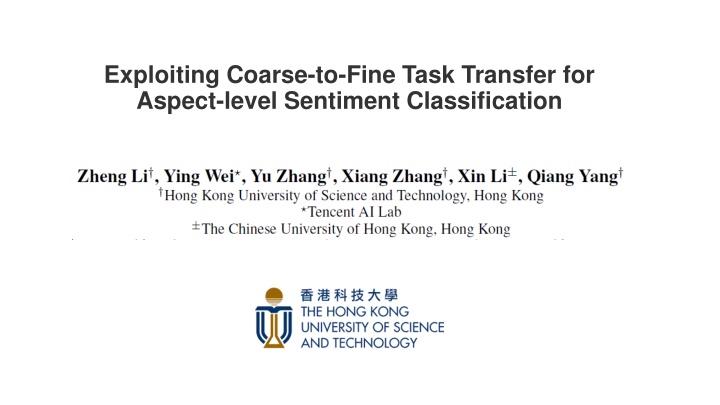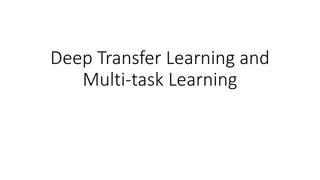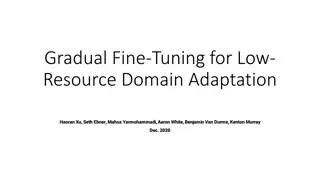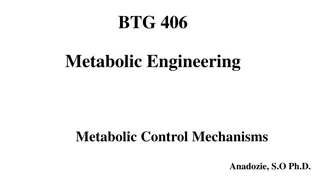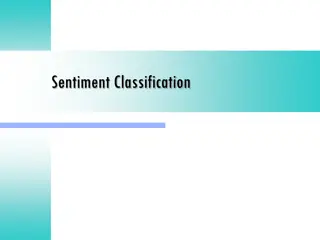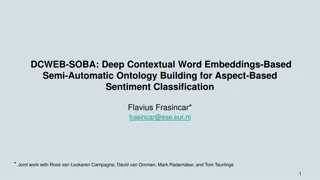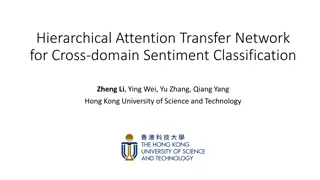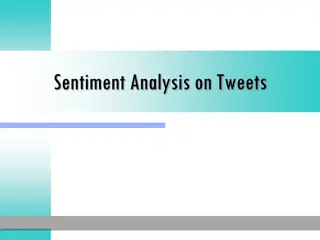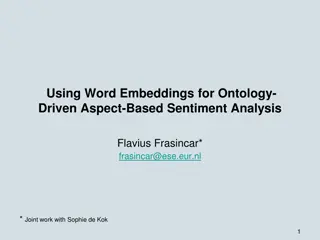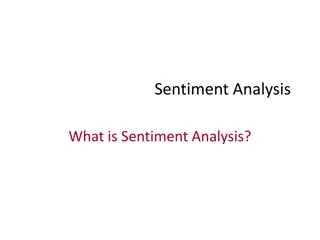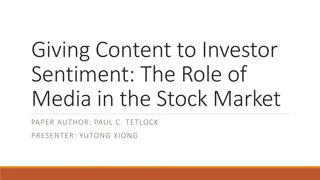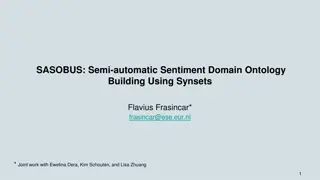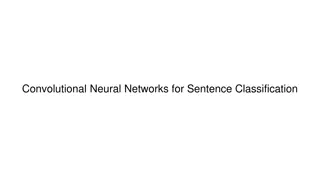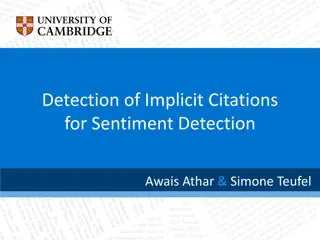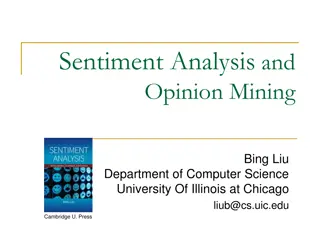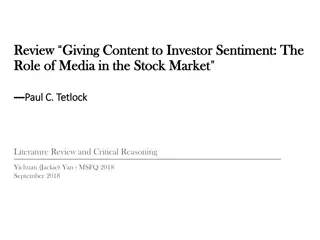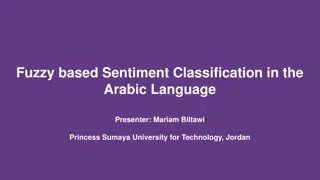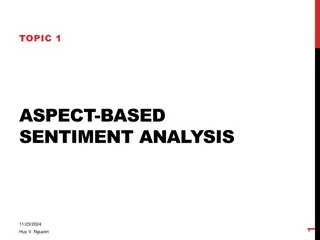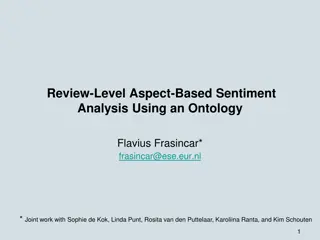Coarse-to-Fine Task Transfer for Aspect-Level Sentiment Classification
Inferring overall opinions and sentiments from user reviews towards specific aspects is crucial for commercial applications like targeted recommendation and advertisement. This study explores the transfer of tasks from coarse-grained aspects to fine-grained aspects for more accurate sentiment analysis.
Download Presentation

Please find below an Image/Link to download the presentation.
The content on the website is provided AS IS for your information and personal use only. It may not be sold, licensed, or shared on other websites without obtaining consent from the author.If you encounter any issues during the download, it is possible that the publisher has removed the file from their server.
You are allowed to download the files provided on this website for personal or commercial use, subject to the condition that they are used lawfully. All files are the property of their respective owners.
The content on the website is provided AS IS for your information and personal use only. It may not be sold, licensed, or shared on other websites without obtaining consent from the author.
E N D
Presentation Transcript
Exploiting Coarse-to-Fine Task Transfer for Aspect-level Sentiment Classification
Outline 2 Aspect-level Sentiment Classification Background & Motivation Problem Definition: coarse-to-fine task transfer Multi-Granularity Alignment Network (MGAN) Coarse-to-Fine Attention (reduce task discrepancy) Contrastive Feature Alignment (reduce feature distribution discrepancy) Experiment Settings Comparative Study Future work
Background Aspect-level Sentiment Classification (ASC) is to infer the overall opinions / sentiments of the user review towards the given aspect. (P(y | a, x)) - The input: Aspect: phrase of opinion entity. (a) Context: the original review sentence. (x) 3 - The output : Sentiment prediction (y). Aspect can behave as aspect category (AC) : implicitly appears in the sentence, a general category of the entities. aspect term (AT) : a specific entity that explicitly occurs in the sentence. Example: AC-level task AT-level task Aspect category Sentiment polarity Aspect term Sentiment polarity + food seafood fish salmon + - - service waiter The salmon is delicious but the waiter is very rude. The salmon is delicious but the waiter is very rude.
Motivation Why Transfer? 4 Aspect-level sentiment analysis - current solutions : RNN (sequential patterns) + attention mechanism (aspect-specific context features) Data-driven, depend on large corpora. The state-of-the-art methods still cannot achieve satisfactory results. Aspect-level sentiment analysis concerning with providing polarity detection at a more fine-grained level, is intuitively more suitable for commercial applications like targeted recommendation and advertisement. Besides, existing domain adaptation tasks for sentiment analysis focus on traditional sentiment classification without considering the aspect.
Motivation What to transfer? (A? -> B?) 5 AT-level dataset (B) aspect terms are required to be comprehensively manually labeled or extracted by sequence labeling algorithms from the sentences. low-resource, expensive, limits the potential of neural models. AC-level dataset (A) aspect category can be pre-defined, a small set. rich-resource, beneficial auxiliary source domains. More easily to collect: commercial services can define a set of valuable aspect categories towards products or events in a particular domain. (e.g., food , service , speed , and price in the Restaurant domain)
Problem Definition Coarse-to-Fine Task Transfer: (new transfer setting) Both the domains and task granularities are different. 6 Source domain (Restaurant) AC-level task: Coarse-grained aspect Aspect category Sentiment polarity < food seafood fish, +> < service, - > The salmon is delicious but the waiter is very rude. AT-level task: Fine-grained aspect Target domain (Laptop) Aspect term Sentiment polarity < screen, +> < system, - > Screen is crystal clear but the system is quite slow.
Challenges 7 Task discrepancy: inconsistent aspects granularity between tasks. Source aspects: coarse-grained aspect categories, lack a priori position context information. Target aspects are fine-grained aspect terms, which have accurate position information. Feature distribution discrepancy: the distribution shift for both the aspects and its context. Example: Restaurant domain: tasty & delicious are used to express positive sentiment for the aspect category food . Laptop domain: lightweight & responsive indicate positive sentiment towards the aspect term mouse .
How to transfer? 8 Multi-Granularity Alignment Network (MGAN): Source Network for AC task: (BiLSTM+C2A+C2F+PaS): one more coarse2fine attention layer Target Network AT task: (BiLSTM+C2A+PaS): a simple, common, attention-based model.
Model Overview 9 The proposed MGAN consists of the following five components: Bi-directional LSTM for memory building - Generate contextualized word representations. Context2Aspect (C2A) Attention: - Measure the importance of the aspect words with regards to each context word, and generate aspect representations. Coarse2Fine (C2F) Attention (tackle task discrepancy) - guided by an auxiliary task, help the AC task modeling at the same fine-grained level with the AT task. Position-aware Sentiment (PaS) Attention - Introduce position information of aspect to detect the most salient features more accurately. Contrastive Feature Alignment (CFA) (feature distribution discrepancy) - fully utilizing the limited target labeled data to semantically align representations across domains.
Align aspect granularity - Coarse2Fine (C2F) Attention 10 position information is effective for better locating the salient sentiment features. Target task: AT-level C2A attention Tech at HP Tech at HP is very professional but the product is quite insensitive. PaS attention Source task: AC-level C2F attention: capture more specific semantics of the aspect category and its position information conditioned on its context. C2A attention food seafood fish The salmon is delicious but the waiter is very rude. PaS attention
Align aspect granularity - Coarse2Fine (C2F) Attention 11 The C2F attention layer consists of three parts: (1) Learning coarse-to-fine process based on an auxiliary self-prediction task: the auto-encoders' manner of reconstructing itself => predicting itself. no need for any additional labeling. Attention mechanism: source aspect ??is not only regarded as a sequence of aspect words, but also as a pseudo-label (category of the aspect) ??, where c C and C is a set of aspect categories. ?tanh ????;?? exp(?? ? =1 exp(?? ? ???. ?= ?? ?+ ??, ?? ?) ?= ?? ?), n ?a= ?? ?=? Auxiliary loss: ?? 1 ?? ?=1 ?) ?log( yk ???= ?? ? ?
Align aspect granularity - Coarse2Fine (C2F) Attention 12 (2) Dynamically Incorporating more specific information ?aof aspect category. - Basic idea: there may not exist corresponding aspect term when the context implicitly expresses a sentiment toward the aspect category. Fusion gate ? : similar to highway connection (Jozefowicz et. al 2015) W[??; ?? ?+ (? ?) ??. ?]+b b), ? =sigmoid(W ?? ?= ? ?? ? (3) ) Exploit position information with the aid of the C2F attention ?? - Basic idea: Up-weighting the words close to the aspect and down-weighting those far away from the aspect (e.g., great food but the service is dreadful. ). ?can help establish the position relevance with the aid of a location C2F attention ?? matrix ?. the ? th context word closer to a possible aspect term with a large value in f will have a larger position relevance ?? ?. ? ? ?, ?,? 1,? . ??? = 1 ?? ?. ?= ????
Align aspect-specific representation - Contrastive Feature Alignment (CFA) 13 The existing unsupervised domain adaptation methods may be impractical: The effectiveness depends on enormous unlabeled target data (expensive: annotations of all aspect terms in the sentences). Contrastive feature alignment (CFA) semantic alignment: ensure distributions from different domains but the same class to be similar. semantic separation: force distributions from different domains and different class to be far apart. I. We resort to a point-wise way: ?? & ??: the source and target network. ?,?? ?)) ?,?? ?,??(?? ???= ?(???? ?,? II. Contrastive function: ? ?= y? ? y? if y? if y? 2 ? ? max(0,? ? ? ?(?,?) = ? 2) ?:the degree of separation
Alternating Training 14 Training objective Simultaneously align aspect granularity and aspect-specific representations. for the source domain + ???+ cfa+ ??? ? ? ???= sen sentiment loss auxiliary loss transfer loss regularization for the target domain ? ? ???= sen + cfa+ ??? sentiment loss transfer loss regularization
Experiment Setup 15 source target AC-level AT-level New corpus: YelpAspect Multi-domains: Restaurant, Hotel, Beautyspa Large-scale: 100K samples for each domain. The dataset is available at the github. https://github.com/hsqmlzno1/MGAN Public benchmarks Multi-domains: SemEval 2014 ABSA challenge (Kiritchenko et al., 2014): Laptop, Restaurant Twitter: collected by (Dong et al., 2014) Small-scale: 1K-3K samples for each domain. Baselines Non-Transfer: - AE-LSTM, ATAE-LSTM (Wang et al. 2016): - TD-LSTM (Tang et al. 2015) - IAN (Ma et al. 2017) - MemNet (Tang, Qin, and Liu 2016) - RAM (Chen et al. 2017) Transfer: - SO: source only - FT: Fine-tuning - M-DAN: multi-adversarial NN (Ganin et al. 2016) - M-MDD: multi-MMD (Gretton et al. 2012).
Comparison with Non-Transfer 16 Conclusion 1: Even with a simple model for the target task, our model can achieve the best performances than all existing non-transfer methods. Conclusion 2: C2F module can effectively reduce the aspect granularity gap between tasks such that more useful knowledge can be distilled to facilitate the target task.
Comparison with Transfer 17 Conclusion 3: When it is hard to obtain enormous unlabeled data, CFA can effectively utilize the few labeled data by considering inter/intra-class relations between domains.
Contribution 20 To the best of our knowledge, a novel transfer setting cross both domain and granularity is first proposed for aspect-level sentiment Analysis A new large-scale, multi-domain AC-level dataset is constructed. The novel coarse2fine attention is proposed to effectively reduce the aspect granularity gap between tasks
Future work 21 Transfer between different aspect categories across domains. Transfer to a AT-level task where the aspect terms are also not given and need to be firstly identified (joint term extraction and aspect sentiment prediction).
Thank You! Questions?
